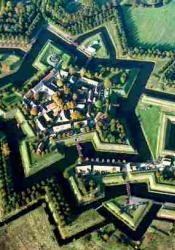
With the new and "booming" age of gunpowder, traditional fortress designs were rendered useless and indefensible. Modern cannons could easily destroy walls that were previously thought to be impenetrable. Famed Italian political scientist Machiavelli is quoted as saying, "There is no wall, whatever its thickness, that artillery will not destroy in only a few days." However, in the mid 1500s, circa 1530, #Michelangelo designed a revolutionary type of fortress that could withstand heavy fire from cannons and bombards. His design involved round or square shaped walls that came together at multiple diamond shaped points. Surrounding the fortress were ditches and walls designed to curtail enemy troops into specific regions along the fortress where they were most vulnerable and easily killed. Glacis, or artificial slopes in the land, were also installed to prevent cannon shots at the lower regions of the wall and keep heavy artillery at bay. Unlike previous forts, the star fort eliminated "dead zones" that were sheltered from defensive fire at the rounded pillars at the corners. The star shape eliminated all dead zones by exposing the enemy to fire from all sides. The new fort style required a much larger army to defend, but also required a much larger army to capture. The star fort design would leave Italy and become the preferred fort design for countries around the world. Thanks to its ingenious engineering, well designed geometry, and sturdy construction, the star fort would prove to be an effective defense against the ever-evolving cannons and artillery of the 1500s.
http://benedante.blogspot.com/2011/06/leonardos-fortress.html
#Leonardo's #Fortress - bensozia
14 Jun 2011 ... ... and modernizing castles for Cesare Borgia, #LeonardodaVinci sketched in his notebook a design for a radically new kind of fortress.
#starfort
Cannon were already pretty effective siege weapons by the early fifteenth century, and the bastion design--with low walls of earth and brick that could withstand cannon better than the high stone walls of the pre-gunpowder era--was already well along by the time Leonardo came around. Gillingham has some good stuff on bastions in his War of the Roses book (his point being that bastions were NOT built in #England because England was actually very #peaceful ! during the period, with only brief periods of fighting resolved by battles, rather than the dragged-out wars of sieges they fought on the continent, where towns spent fortunes replacing their #medieval walls with bastions).






